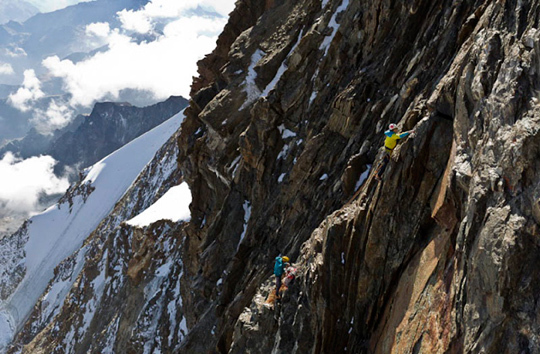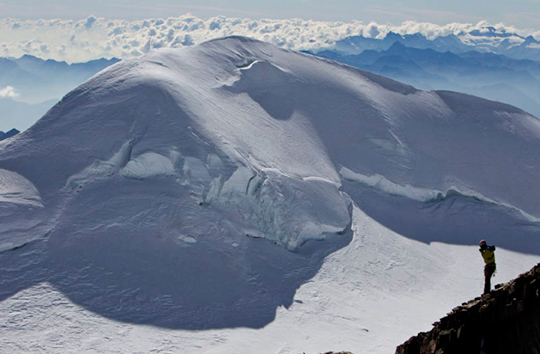
Herve leading above Marco Barmasse on their new route on the Signalkuppe (4554m). [Photo] Damiano Levati/The North Face
On September 30, 2011, Italian climbers Marco and Herve Barmasse, a father and son from Northern Italy, established a new route on the southeast face of Signalkuppe (4554m), a peak in the Monte Rosa massif. The 800-m route (ED) signifies the end of Herve Barmasse’s “Exploring the Alps” project, in which he put up new routes on three of the range’s most prominent peaks–the Matterhorn, Mont Blanc and finally Monte Rosa.
Signalkuppe is rarely visited. The first ascent of this peak was completed in 1906 by Guglielmo Guglielminetti, Alessandro Orio and Fabio de Zinis via a direct route to the summit (D). In 1987 Italian mountain guide Silvio Mondinelli, along with Fabio Loss and Paolo della Valentina, put up route Africa Nostra (TD+), a route on unstable rock that has likely never witnessed a second ascent.
The Barmasses’s route is on the unexplored face to the left of Africa Nostra, ascending the face on rock and ice before joining with the southwest ridge just fifteen meters before the summit. Herve Barmasse chose to climb on the south face of Signalkuppe largely because it can be admired from the Duomo in Milan, yet the face is largely vacant of routes. The route on Signalkuppe is mostly climbing in the 5.9/5.10 range, but with frequent rockfall and sparse protection opportunities, Herve warns future climbers not to underestimate it.

Herve Barmasse on the summit of the Signalkruppe (4554m). [Photo] Damiano Levati/The North Face
This climb constitutes a fitting end to the Exploring the Alps project. Herve’s motivation for the undertaking was to “rediscover the mountains where alpinism originated and endeavor to keep the spirit of adventure alive as much as possible” by climbing new routes in alpine style on three very popular peaks. To Herve, it is the search for what is “new and remote” that makes authentic alpinism–and new and remote places have diminished greatly in the Alps, with the proliferation of ski lifts and staffed huts. Herve’s project served to remind people that true adventure and unexplored lines do exist in the popular mountain range, but “to find this authentic spirit [of alpinism]…you have to trust your imagination.”
The first installment of the Exploring the Alps project came in April when Barmasse ascended the south face of the Matterhorn solo via a new route. The second climb of Barmasse’s trilogy occurred in August when Barmasse and brothers Iker and Eneko Pou established new route “La Classica Moderna” on the Left Pillar of the Brouillard on Mont Blanc.
Barmasse says that of the three climbs that comprised his project, the route up Signalkuppe held special importance because he climbed it with his father. His father, a renowned mountain guide who put up many routes on the Matterhorn, taught Herve much of what he knows about the mountains. Though the two climb together infrequently, Herve says that his father taught him that alpinism is more than just physical an technical prowess. “A good alpinist should not only have good technical and physical capabilities, but also respect, passion and love for the mountain,” Herve says his father taught him. “Mountains are climbed with muscles and breath but they need to be loved with your heart as you love a woman.”